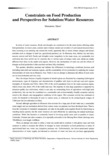Constraints on Food Production and Perspectives for Solution: Water Resources
JIRCAS international symposium series
| ISSN | 13406108 |
|---|---|
| 書誌レコードID(総合目録DB) | AA1100908X |

本文フルテキスト
intlsymp-12_63-72.pdf1.28 MB
In terms of water resources, floods and droughts are considered to be the main factors affecting stable food production. In recent years, extreme cases (various extents and severities of such natural disasters) have been occurring at an alarming rate around the world, apparently due to recent climate changes and human activities such as changes in land use, agricultural practices, etc. In Monsoon Asia, distinct dry and rainy seasons coexist and both floods and droughts occur irregularly in the same areas, yet sustainable rice cultivation has been carried out for centuries due to various types of unique water uses which are totally different from those in dry and/or arid regions. However, the mechanisms of water use and the effects of changes on food production in this area have not been fully elucidated.
The speaker, therefore, presents and outlines the differences in hydrologic conditions between arid (including semi-arid) and monsoon regions, and the sustainability of rice production by analyzing the unique characteristics of water use in Monsoon Asia. There is also an attempt to determine the effects of such water use on food production and vice versa.
First, the unique features of paddy irrigation in humid regions are illustrated by comparing hydrological environments, types of irrigation, and characteristics of paddies with those in arid and semi-arid regions (examples of Australia and USA). About 54% of the world population lives in the Asian monsoon region, which covers only about 14% of the world land area. The majority of Asia large population is supported by intensive paddy rice cultivation, which is not only an outstanding form of agriculture with high land productivity, but can also be considered as a sustainable and environmentally friendly economic activity suited to the climatic and topographical conditions of the region. This economic activity has continued to evolve for hundreds or thousands of years in various areas, as witnessed by the archaeological vestiges of 7,000-year-old rice cultivation in China.
Second, although agriculture in Monsoon Asia accounts for a large part of total water use, a sustainable water supply and use mechanism derived from various water use patterns, has been developed there. That is, from the viewpoint of watershed management, not only do the paddy areas regulate floods by functioning as retarding basins (ponds), but the water resources are used effectively by optimizing the natural hydrologic conditions. While this function is commonly found in low-lying paddy areas such as paddies in Japan, Cambodia, Vietnam and other countries, it is especially noticeable in the Mekong River Basin (drainage area: 790,000km2, river length: 4,400km).
Third, an attempt was made to refine a water use model and to combine it with global water and food analyses in order to examine the effects of changes in water circulation on food production in terms of agricultural land use, water use, irrigation patterns, etc. Unfortunately, the above-mentioned unique characteristics of water supply and demand as elements of water use have not yet been appropriately considered in many "world water and food" models that have been developed since 1990 at many research institutes, such as JIRCAS, IFPRI, and IWMI.
The speaker, therefore, presents and outlines the differences in hydrologic conditions between arid (including semi-arid) and monsoon regions, and the sustainability of rice production by analyzing the unique characteristics of water use in Monsoon Asia. There is also an attempt to determine the effects of such water use on food production and vice versa.
First, the unique features of paddy irrigation in humid regions are illustrated by comparing hydrological environments, types of irrigation, and characteristics of paddies with those in arid and semi-arid regions (examples of Australia and USA). About 54% of the world population lives in the Asian monsoon region, which covers only about 14% of the world land area. The majority of Asia large population is supported by intensive paddy rice cultivation, which is not only an outstanding form of agriculture with high land productivity, but can also be considered as a sustainable and environmentally friendly economic activity suited to the climatic and topographical conditions of the region. This economic activity has continued to evolve for hundreds or thousands of years in various areas, as witnessed by the archaeological vestiges of 7,000-year-old rice cultivation in China.
Second, although agriculture in Monsoon Asia accounts for a large part of total water use, a sustainable water supply and use mechanism derived from various water use patterns, has been developed there. That is, from the viewpoint of watershed management, not only do the paddy areas regulate floods by functioning as retarding basins (ponds), but the water resources are used effectively by optimizing the natural hydrologic conditions. While this function is commonly found in low-lying paddy areas such as paddies in Japan, Cambodia, Vietnam and other countries, it is especially noticeable in the Mekong River Basin (drainage area: 790,000km2, river length: 4,400km).
Third, an attempt was made to refine a water use model and to combine it with global water and food analyses in order to examine the effects of changes in water circulation on food production in terms of agricultural land use, water use, irrigation patterns, etc. Unfortunately, the above-mentioned unique characteristics of water supply and demand as elements of water use have not yet been appropriately considered in many "world water and food" models that have been developed since 1990 at many research institutes, such as JIRCAS, IFPRI, and IWMI.
| 作成者 | Takao Masumoto |
|---|---|
| 公開者 | Japan International Research Center for Agricultural Sciences |
| オンライン掲載日 | |
| 号 | 12 |
| 開始ページ | 63 |
| 終了ページ | 72 |
| 言語 | eng |
